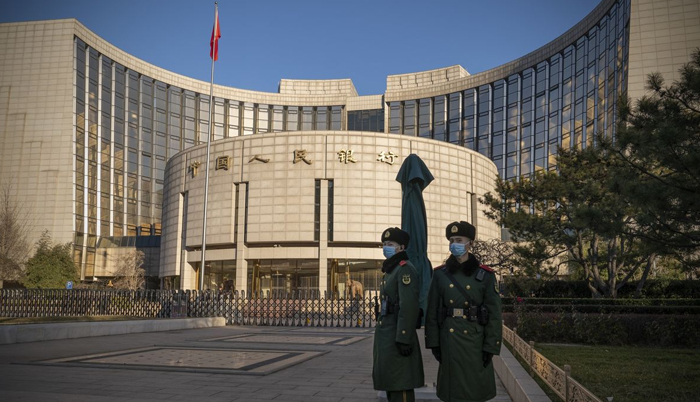![]() Home > World Business
Home > World Business
China’s Central Bank Takes Modest Easing Path Despite Covid

![]() April 16th, 2022 | 17:04 PM |
April 16th, 2022 | 17:04 PM | ![]() 867 views
867 views
CHINA
China’s central bank gave lenders a modest cash boost on Friday and refrained from cutting interest rates, taking a cautious approach with monetary easing despite the worst Covid outbreak in two years taking a toll on the economy.
The People’s Bank of China reduced the reserve requirement ratio for most banks by 25 basis points, lower than economists had expected, and dropped it by 50 basis points for smaller lenders. It kept the one-year policy interest rate unchanged, disappointing the majority of economists who predicted a cut.
The modest action indicates restraint from the central bank in the face of interest rate hikes in the U.S. and elsewhere and rising inflation risks. It also suggests monetary policy easing may have limited effect in boosting growth when most of the pressures are coming from China’s tough approach to combating Covid infections.
“The main challenge the economy faces is the omicron outbreaks and the lockdown policies that restrict mobility,” said Zhang Zhiwei, chief economist at Pinpoint Asset Management. “More liquidity may help on the margin, but it doesn’t address the root of the problem.”
The RRR change, effective from April 25, will unleash about 530 billion yuan ($83 billion) of long-term liquidity into the economy, the central bank said. The PBOC last reduced the ratio in December.
“Given the smaller-than-expected RRR cut and the central bank’s concerns over inflation and Fed hiking, we no longer expect policy rate cut or further RRR cut in our baseline,” Goldman Sachs Group Inc. analyst including Hui Shan wrote in a report Saturday.
Chinese banks are due to decide on the loan prime rates -- the de-facto benchmark lending costs -- on April 20. While some economists have expected a reduction in the rates, the Goldman Sachs analysts said that is unlikely to be delivered this month as the RRR cut will take effect toward the end of April and the costs the policy can save for lenders seem “too small.”
The RRR cut was signaled by the State Council, China’s cabinet, at a meeting on Wednesday, and followed repeated warnings from top officials about risks to growth and the need for more monetary and fiscal stimulus. Economists have been downgrading their growth forecasts for the year to well below the government’s target of around 5.5%.
The cut “was clearly done begrudgingly,” Craig Botham, chief China economist at Pantheon Macroeconomics Ltd., wrote in a note. The 25-basis point is the smallest monthly drop in the RRR on record, he said.
Earlier Friday, the PBOC refrained from cutting interest rates and injecting extra liquidity into the economy via the medium-term lending facility. At the same time, authorities urged commercial lenders on Friday to lower their deposit rates, according to people familiar with the matter, a move to help ease funding costs for banks so they can boost lending.
Loan demand remains weak amid lockdown measures and a property market slump, and banks are unwilling to lend in an increasingly risky environment, Botham said. That means any rate cut will only have “minimal effect on economic growth,” he said.
A hawkish Fed is also narrowing policy space for the PBOC. Tighter monetary policy in the U.S. has already wiped out China’s yield premium over U.S. Treasuries, fueling capital outflows and threatening the yuan.
Acknowledging liquidity is already at a “reasonably” ample level, the central bank said it will continue to take a prudent monetary policy, avoid flooding the economy with stimulus, and make better use of aggregate and structural policies. One aim of the RRR cut, it said, is to guide banks to use the fresh funds to support industries and small businesses hit hard by the pandemic.
The weighted average ratio for banks will drop to 8.1% after the reduction, the PBOC said in a statement, down from 8.4% previously.
The central bank will closely watch the changes in inflation trends to ensure stable prices, while also monitoring monetary policy changes in major economies, it said.
Cutting the RRR is an effective way to unleash cheap long-term liquidity. With local governments speeding up infrastructure bond sales, the cash boost may help banks to finance the surge in the debt supply.
The room for further RRR reductions may be shrinking though. Economists say the central bank may soon need to shift away from widespread use of the RRR as it’s already relatively low and is becoming a less effective tool to deal with the economy’s structural challenges.
The “risk of recession” in China has been rising and global markets could be underestimating that, Nomura Holdings Inc. analysts led by Lu Ting wrote in a note late Friday.
“We believe changes to China’s Zero Covid strategy are key to a growth recovery in coming months,” they said. RRR and rate cuts alone are hard to boost credit demand as “households scramble to stockpile food and private corporates prioritize surviving over expansion,” they added.
Source:
courtesy of BLOOMBERG
by Bloomberg News
If you have any stories or news that you would like to share with the global online community, please feel free to share it with us by contacting us directly at [email protected]